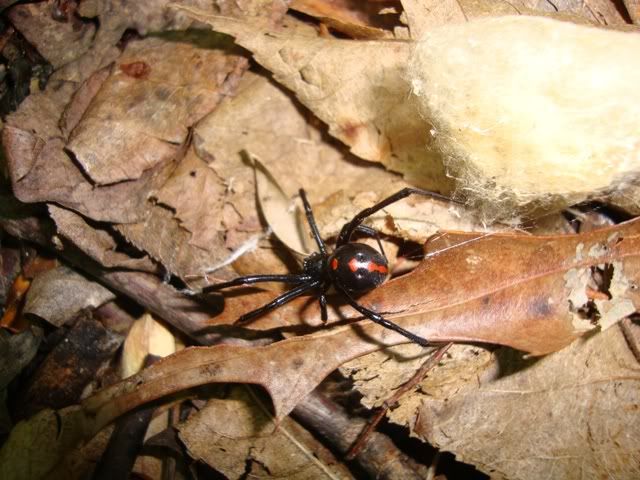So please excuse the excessive posting!
_____________________________________________________________________
The curious thing about using drift fences in the southeast is that some unusual critters will set up shop along the fence itself (not neccessarily be captured in the fence....just live along the fence). Probably the drift fence resident that demands the most respect is the Black Widow (Latrodectus mactans). There are actually many species within the genus Latrodectus (generally referred to as the "widow spiders") and they are found throughout the world. The US is home to four species...but here we have primarily the Southern Black Widow (L. mactans). They are pretty common, and last summer I even found one under the cover of my grill when I went out to cook some burgers one evening.
Black Widows find my drift fences ideal locations to hunker down...spin a web and grab some grub. As a result, I've gotten pretty good at identifying their webs along the fence line. Today, as I went to set traps, I noticed some fresh webbing that looked like it belonged to a widow. The web was very haphazard and "cob webby" looking. It was also near a place along the fence where the fence material had folded over at the top. Both of these are clues that the web belongs to a Black Widow. They like tight, dark places and often hide in the folds of the fence material.
So, I took a stick and lifted the fold. Sure enough...there she was...resting carefully within her silken filamentous abode.
Above: The Black Widow's web along the drift fence
Above: the first Black Widow I found along the fence today.
After releasing her, I went back to the fence and walked around to the other side. Here I found yet another Black Widow web. I again lifted the fold of the fence with a stick and saw the Missus sitting there calmly. So, I moved her too. Again, she made no aggressive move and instead opted to pull up into a ball, so that I had to roll her onto a leaf and move her off into the woods.
Above: the second Black Widow I found along the fence today. Note
the charactersistic red marks on the abdomen (often hour-glass shaped).
Their un-aggressive nature is quite obvious. In fact, most human bites occur accidentally and usually under specific circumstances. They like dark, tight places...so many bites occur when folks inadvertently stick their hands into a dark place that has a resident widow (mailboxes, the under side of a shelf in your shed, near the gas valve on your propane grill). Another way to accidentally get bit is by sticking one's feet into shoes that have been sitting outside for awhile.....long enough to have one of these little gals make it their home (I always bang my work shoes out pretty good before putting them on). The result of their neurotoxic venom is a condition clinically referred to as Latrodectism. This is an incredibly unpleasant experience with symptoms lasting for weeks post-bite.
But bites are rare when one considers how common the widow is.
Better safe than sorry...but they are still quite a neat little critter.




There is no such thing as excessive posting when you post interesting stuff. Keep 'em coming!
ReplyDeleteIn South Africa we also have a number of Latrodectus spiders, but I don't think we have L mactans. We tend to call them 'button spiders'and have both brown (L geometricus) and black (L indistinctus) buttons. The browns are very common and I'm amazed that I've never been bitten - they're in most dark quiet places. The 'browns' are not as venemous and, apparently, there are no known fatalities here. However you won't forget the pain in a hurry - and won't forget not to put your hands into quiet dark places again!
Thanks, Jeremy!
ReplyDeleteThe presence of so many black widows 'round here has completely changed how I do field work and how careful I am when my daughter plays outside!
Every little thing that she grabs for or sticks her hand in to that has dark crevices...I stop her and check them carefully first.
We also have the Brown Recluse here...although they are not as common as the widown....
Honestly, the spiders don't worry me as much as the ticks (and tick-born diseases) do....the ticks are THICK in these parts!